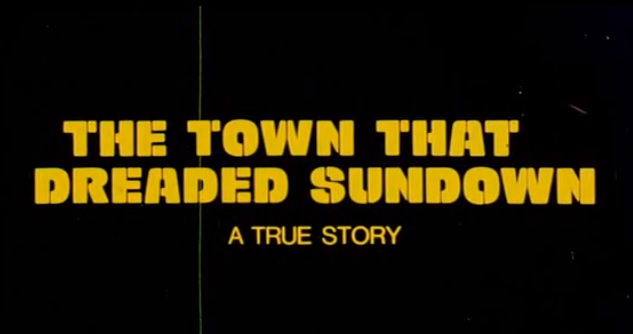 Is a serial- or spree-killer who wears a mask and kills ‘misbehaving’ teens a slasher? If not, then what of Ghostface and fifty other killers, right? But, the slashers we know and love, they usually have a signature weapon, don’t they? Michael’s got his knife, Jason’s got his machete, Leatherface rips that chainsaw to life every chance he gets. But there’s weapons of opportunity, too. Jason’s hardly above getting the job done with a speargun, and Freddy, while he actually wears his signature weapon, as often as not his victims die in ‘dreamy’ ways (barbells, television set, etc). Which is to say, this killer in the new The Town that Dreaded Sundown, he doesn’t limit himself just to that boring old knife. No, this guy, he even goes so far as to break Batman’s cardinal rule: guns. Which his why I’m asking about serial killers vs. slashers, trying to tease apart which is what: shooting lovers parked in their cars out in the woods is a bad story we know from headlines, right? And aren’t slashers a lot more made-up?
Is a serial- or spree-killer who wears a mask and kills ‘misbehaving’ teens a slasher? If not, then what of Ghostface and fifty other killers, right? But, the slashers we know and love, they usually have a signature weapon, don’t they? Michael’s got his knife, Jason’s got his machete, Leatherface rips that chainsaw to life every chance he gets. But there’s weapons of opportunity, too. Jason’s hardly above getting the job done with a speargun, and Freddy, while he actually wears his signature weapon, as often as not his victims die in ‘dreamy’ ways (barbells, television set, etc). Which is to say, this killer in the new The Town that Dreaded Sundown, he doesn’t limit himself just to that boring old knife. No, this guy, he even goes so far as to break Batman’s cardinal rule: guns. Which his why I’m asking about serial killers vs. slashers, trying to tease apart which is what: shooting lovers parked in their cars out in the woods is a bad story we know from headlines, right? And aren’t slashers a lot more made-up?
However, blurring this line, does that up the scare? Does it bring the slasher home to our world, a little?
Maybe, yeah.
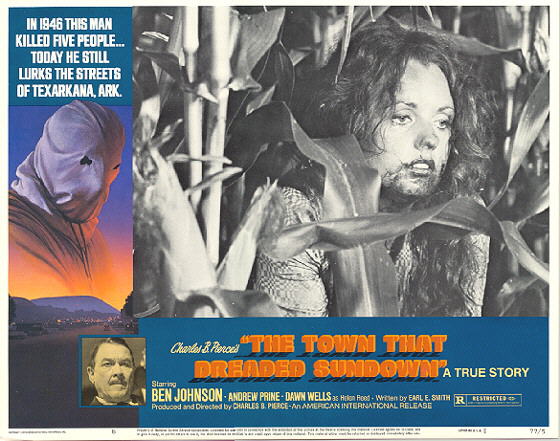
To back up for a moment, though, the original The Town that Dreaded Sundown hit in 1976. A couple of years after Black Christmas but a couple before Halloween codified things up such that the formula could be replicated all through the eighties. And it seriously had one of the all-time best slasher titles ever. Its main contemporary, I think, was Savage Weekend, right? Except Savage Weekend was more for the 42nd Street crowd, I would say. Not that the original The Town that Dreaded Sundown was necessarily aiming for the Oscars—like most horror, it was hoping to cash in at the drive-in—but it was a lot less . . . vile, I guess I would say. Less mean, less ‘exploitational,’ finally. I mean, you can tell that the original is really getting off on speeding around in all those forties cars, can’t you? And playing that funny music over all that ridiculous deputy’s Barney Fife antics? And just generally eating up screen-time with stuff not meant to scare. Like, it had three or four set pieces, and didn’t so much know what to do with the rest, really. Which was fine. And it had some good stuff going on:
- a masked killer (a baghead, which we’d see again in Friday the 13th II, of course)
- teens parked at lover’s lane
- small-town ‘nostalgic’ Texas (which, in the absence of the ‘closed door’ most slashers insist upon, instead put that door at the county line, pretty much)
And, what it also had, that would hardly ever happen after this—it was 1976, remember, Randy’s rules weren’t laid down yet—was not just a task force, which is to say, not just adults who actually believed a killer was out there and were willing to organize against that killer, but a ‘Lone Wolf’ Texas Ranger somehow not named ‘McQuade.’ So, the story we see cuts back and forth from the teens to the adults, the ‘party’ to the cop shop . . . an awkward move, at best. There’s a reason it’s usually not done. There’s a reason Carpenter kept us with the babysitters, not the parents. There’s a reason Craven had the detective-father dismiss all these scary dreams.
There’s a reason the mayor doesn’t shut the beaches, right? If he does, then the monster never appears.
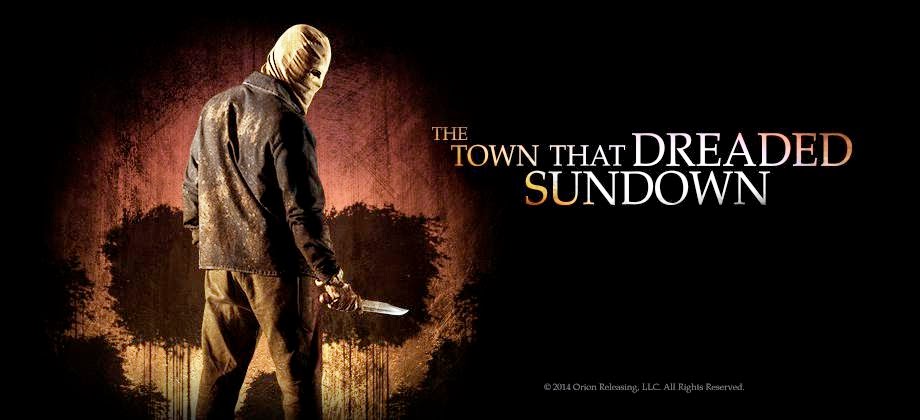
So, what this sequel-remake adds to that mix, it’s A) a refocus on the final girl and her set, and B) the pastor from Footloose. But still present are all the necessary red herrings, all the kids at lover’s lane, small-town Texarkana, the task force, the Texas Ranger, the baghead, the set-piece kills (and some excellent kills they are).
But let’s back up a moment: sequel or remake? I honestly cannot begin to tell. I mean, that it’s a remake is supported by so many of the story beats remaining the same, right down to the names of characters and the very particular, ‘signature’ kills. But, in a how-meta-can-you-get kind of narrative nesting, it also references that 1976 movie, and identifies it as a cheap dramatization of the ‘real’ events from the forties. There’s even a moment where the Texas Ranger from this movie is watching the Texas Ranger who shares his name in the old movie. It’s a very Spaceballs move, and I’d be lying if I said I completely understood the tension. I guess it could just be that some producers wanted it to be a sequel while some wanted a remake, and the writers, ground between conflicting notes as usual, did their best to satisfy both.
I don’t know. If you figure it out, let me know? I haven’t read any of the promo or insider stuff, so this could already be answered somewhere. Just, I can’t imagine how, provided what’s on-screen.
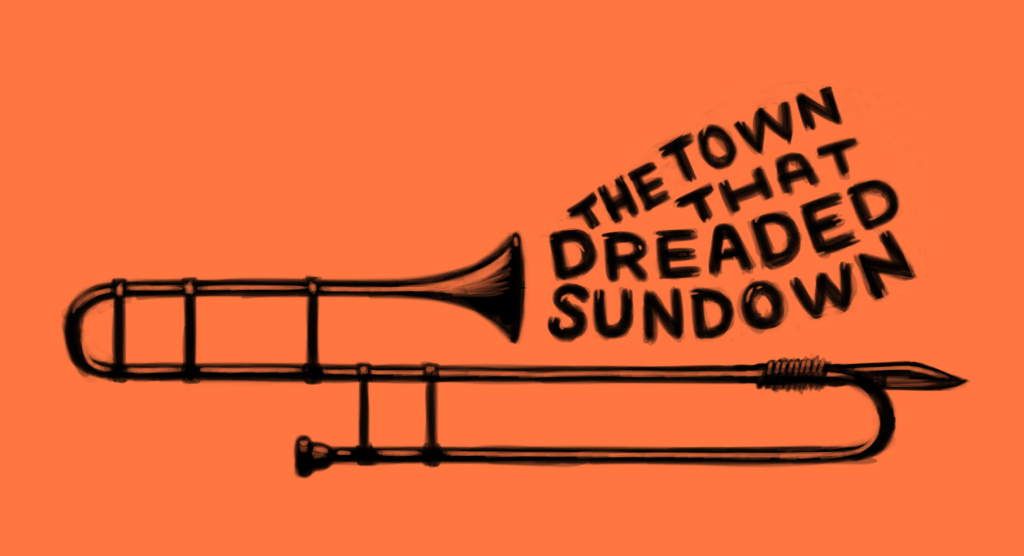
Oh, too: one thing this slasher does that only Freddy ever gets to do, pretty much? He speaks. From the first kill on, he’s a talker. Which of course immediately cues us in that this is one kind of slasher, not another—nothing supernatural, all human motivations (which are nearly always ‘revenge’ for the slasher).
Which is to say, there’s some cool and risky stuff going on here. I’m not completely sure it’s all effective—more on that momentarily—but I appreciate the attempt to inject new DNA into a genre a lot of people consider ‘tired.’ Without innovation and escalation (resulting from competition at the box office), the slasher could go stale, die. And we can’t have that.
And, one thing this The Town that Dreaded Sundown schooled me on, a thing I should have already assumed, as we’ve all seen it so many times, is the fact that it’s not just the slasher who gets an origin story (as big reveal). No, the final girl can, and quite often does, have her own origin story. Which means their big battle, this movie we’re seeing, it really started long ago, like it’s fated to happen. Very cool, veining that sense of ‘providence’ in, I think. It makes the stories more grand, more The Cabin in the Woods important (i.e., ‘we need this ritual to keep the world running’).
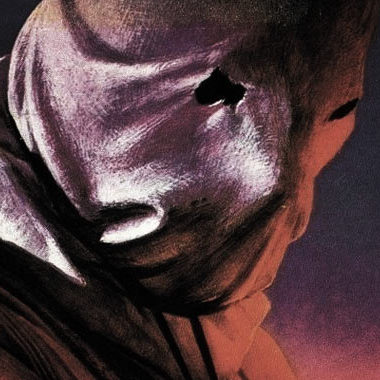 Last, there something very odd about The Town that Dreaded Sundown, too. I can’t quite get my thumb on it like I want, but . . . early on, there’s some shuffle in the projector room, followed by the distinct possibility that this non-sequel not-a-remake remake-sequel-thing we’re watching, it’s itself a movie. Which is freaky—the kind of narrative gameplay I usually go for. But, here, I don’t know. Were it just happening up-front, then I’d have no problem with it all, would applaud it, even. But the way it seems to be working here is that we get these odd and unexpected camera angles, these strange compositions and juxtapositions, and stuff done with lighting that makes the scenes look kind of fake. It’s like, each time we need to invest in this as real, ‘style’ rears its head to remind us that this is all a movie. Which, again, can be fun, but it kind of works against the dynamic by which horror scares you: you ‘think’ this is real, so you flinch. But, with all these reminders that it’s not real, it’s increasingly more difficult to invest such we can feel any dread.
Last, there something very odd about The Town that Dreaded Sundown, too. I can’t quite get my thumb on it like I want, but . . . early on, there’s some shuffle in the projector room, followed by the distinct possibility that this non-sequel not-a-remake remake-sequel-thing we’re watching, it’s itself a movie. Which is freaky—the kind of narrative gameplay I usually go for. But, here, I don’t know. Were it just happening up-front, then I’d have no problem with it all, would applaud it, even. But the way it seems to be working here is that we get these odd and unexpected camera angles, these strange compositions and juxtapositions, and stuff done with lighting that makes the scenes look kind of fake. It’s like, each time we need to invest in this as real, ‘style’ rears its head to remind us that this is all a movie. Which, again, can be fun, but it kind of works against the dynamic by which horror scares you: you ‘think’ this is real, so you flinch. But, with all these reminders that it’s not real, it’s increasingly more difficult to invest such we can feel any dread.
It’s an odd choice, I’m saying. In an odd movie. One which I’m glad I finally VOD’d. The slasher is more and more an animal with motile skin, it seems. And even the bones under there, they’re rejointing into other places, such that the shadow this creature casts, its getting less and less recognizable. Which is fun, and necessary. Just, midway through all these contortions . . . that shadow on the wall can come off a bit ungainly.
However, The Town that Dreaded Sundown . . . there’s something about it that makes me suspect that ungainliness is part of the intent, somehow. That I’m just not quite getting it.
Too, every slasher kind of makes or breaks itself on its closing image, yes? If that’s the case, then I submit that this The Town that Dreaded Sundown has no worries, as it closes in very cool, very self-aware fashion. Slashers are always a joke. Just, a joke with teeth. When it smiles, you can see them all. The Town that Dreaded Sundown, right at the end, it smiles, shows us a mouthful.




